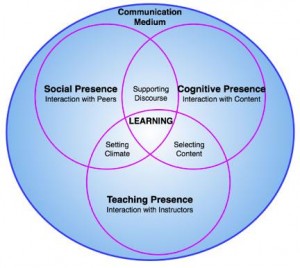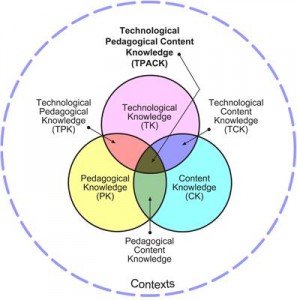Final e-Portfolio Synthesis.
The following reflection is my attempt to synthesize the course and consolidate learning.
-
1.Precis of Flight Path
Reviewing my initial flight plan for the course, my goal was to have a better understanding of online course development and various Learning Management Systems, Web 2.0 tools, multimedia, and assessment especially for ‘Blended’ Learning environments. In my district, numerous teachers are implementing a variety of different online tools (i.e. wikis, blogs) within their current curriculum delivery not only to enhance the program, but to increase both student engagement and achievement. In addition, I wanted to explore a LMS solution which could be used for teacher professional development (fully online and blended).
I also wanted to explore assessment further as it related to tasks or assignments completed online by students. Considering the focus on improving student writing in my district (across the province of Ontario) there has been some discussion that online writing; such as discussion posts, may not have the same evidence of higher level thinking skills.
-
2. eLearning Toolkit Reflection
The eLearning Toolkit provided a wealth of information, including quick links to tools such as main stream and emerging technologies that could be effectively implemented in online and blended learning. The toolkit is setup as a wiki, which I appreciate as an authentic use of the tool itself. I found myself spending numerous hours within the toolkit exploring social software, weblogs, and multimedia. I often had to give myself a time limit.
The content on HTML authoring, webpage design, and storyboarding was very useful. Several years ago I had been asked to do some web page design lessons for intermediate and secondary grades. With the ease now of designing a webpage with editors, it is possible to create a webpage without knowing HTML code. I was reminded of the need and usefulness to know code as there are times when WYSIWYG editors are limiting. I have revisited some of these lessons that I used to conduct and may revisit them with classrooms.
The multimedia and authoring tools resources were especially useful, as this is an area where I provide support to teachers (at specific times of the school year….Kindergarten and grade 8 graduations). Multimedia presentations are such an effective way to tell or re-tell a story and celebrate learning; however, as mentioned, it is an area understood by few general computer users. Digital camera and Photoshop workshop requests also continue to be very high. This is encouraging as it testifies to the fact that teachers are encouraging their students to create content in a variety of different ways.
I have saved most, if not all, of the resources from the UBC wiki eLearning Toolkit in to my own Delicious account for future reference and sharing purposes.
-
3. My Overall ETEC 565 Experience
I have thoroughly enjoyed the practical nature of this course and the opportunity to explore and create. Each of the MET courses I have taken so far have had an impact on me and my work with JK-12 teachers. ETEC 565 has certainly had a positive impact.
I tend to enjoy both small group work and individual assignments, but struggle with discussions posts. I appreciate the opportunity to work on major assignments individually which suits my learning style.
When I refer back to Module 1, I am reminded of the importance of conceptualizing a framework. These were ISTE standards, SECTIONS (Bates and Pool, 2003) and the 7 Principles of Good Practice in Undergraduate Teaching (Chickering & Gamson, 1987) (applicable to other education settings). I have found myself referring back to the standards for teachers and student several times throughout the course. Although they are a bit overwhelming when viewed in their entirety, I have tried to focus on individual components and have encouraged teachers to focus on pieces in their effort to implement. Standards are often questioned as limiting or too demanding. I am hopeful that Canada and/or the province of Ontario will adopt or implement some standards.
Technology changes quickly and the SECTIONS framework provided the much needed structure to evaluate systems rather than basing decisions on emotion or ‘gut feelings’ or the bottom line – often cost. I would like to suggest an additional principle of practice to include in the 7 principles of good practice – identify success criteria.
In Module 2, I am reminded of LMS platform evaluation, rubric creation and our Group assignment, and professional development delivery methods. One of my goals in my flight path was to explore various LMS platforms. This Module allowed me to view the LMS within a context. As an aside, Ontario’s provincial eLearning strategy utilizes Desire 2 Learn. This fall, the current contract with D2L will expire and eLearning Ontario put out its RFP (request for proposals) to vendors. I wonder if the Ministry of Education uses a similar rubric to those that we created.
Module 3 focused on interaction tools, assessment and evaluation. Student success in face to face classes often can be attributed to the interactions and relationships established. The same can be said of online learning environments. It may be more of a challenge to create this collaborative, caring community, but success is worth it. I immediately thought of the live session in our class where John provided live information regarding Moodle, which provided an opportunity for connecting on a different level, perhaps appealing to the range of intelligence and learning styles. I would have enjoyed more opportunities for this type of exchange.
Regarding assessment and evaluation, I had limited knowledge and experience using LMS tools for this purpose (aside from online survey tools to collect feedback). I was impressed by the range of options within Moodle that provides feedback to students and how this could be used for assessment of, as, and for learning. This is a great example of how in a blended environment, online quizzes could be used for students to take pre and post assessments to guide their own learning, or for teachers to plan instructional next steps. Feedback could be provided indicating correct answers, but also referring learners back to the course content to find the answers. The ability to allow for multiple attempts allows for student success. I enjoyed the opportunity to create an assessment tool and appreciate the time involved. Once they have been created they could be modified and re-cycled, in the long term saving time.
In Module 3, I also made connections to the Venn Diagram, Community of Inquiry Model (Garrison, Anderson and Archer (2000) illustrating learning occurring where there is meeting of social presence, cognitive presence, and teaching presence being optimal for learning.

This immediately reminded me of the diagram used in the TPACK framework for the effective integration of technology in the knowledge domains of: technology, pedagogy, and content.

http://tpack.org
Module 4 – Social Media was my favourite module as we explored private and public spaces – an ongoing, necessary conversation as students and teachers do not fully understand the concept of the digital footprint. I found Alan Levine’s reference of 50 Ways to Tell a Digital Story to be particularly engaging. This has proved to be a very useful reference tool and guide and would make for a great task for students from gr. 7-12 (possibly even younger) especially give the new Media Literacy strand within Ontario’s Language Arts/English curriculum. I enjoyed exploring the various tools Alan listed. I was discouraged by the number of sites blocked by our school filters. At home, numerous hours were spent exploring these web 2.0 tools. I forget how many free accounts I signed up for.
This module also made me re-examine the concept of being published. Certainly, copyright continues to be a huge concern within most school boards as we our challenged to model the ethical and responsible use of information. This in itself is a huge shift as I recall the thought not so many years ago that if it were on the internet than it was fair game for any use.
Module 5 – Multimedia. I have to be honest, even though this was the most recent Module, being consumed by the LMS and Educational Toolkit during this time, I had to go back to review the main ideas. As with any discussion regarding technology, “effective use” or the “what” and “why” should be common questions regardless of the tool. In an eLearning environment, I would argue that multimedia is imperative to engage students and encourage success. Differentiated instruction and appealing to the multiple intelligence should be taken in to consideration regardless of the delivery method.
4. Next Steps:
This is the halfway point through my MET learning journey, I look forward to opportunities to continue to explore and learn about online learning platforms and tools. As mentioned previously, we have several teachers and students using Desire2Learn, I intend to learn more about the various under-utilized tools within D2L to help support teachers with the effective use of assessment tools and the range of uses (surveys, quizzes).
I plan to explore Moodle further and to actually implement this as a tool for teacher professional development to help model its use and to hopefully create a community of interest. This tool would provide a consistent method of delivery where teachers and students could be better supported. This is not to discount other tools such as wikis and blogs, but rather establish greater consistency. I would like to integrate the Moodle course site created for this course in to actual professional development I am providing, therefore I need to export the units to a Board Moodle.
Next term I plan to take ETEC 510 which seems to complement this course, design of technology-supported learning environments – “online seminar examining research, and exemplary media tools, as they inform the design of technology-mediated environments. Constructivist and sociocultural theories of mind, learning and instruction and their significance for the design of educational technologies and environments will be explored. Students will design a technology-supported learning environment”.
Along with my learning in the MET program, a very useful professional learning network for me has been Twitter. It’s a great tool for staying current and aware of emerging issues and trending emerging educational topics. I continue to find my “own voice” using this tool as I do in my online courses. This brings me to my next, “next step” and that my participation needs to be more active. I think more research is needed regarding “silent participants” or “lurkers”, which always seems to have a negative connotation to me. I recognize that in an online learning environment, discussion and collaboration is important. I think I have identified some strategies that work for me from previous courses – they include small group work online (I wonder how small group discussions might help), live chats and interactions. Looking ahead ETEC 510 has a 25% online discussion participation mark.
With teachers I am working with, I hope to implement a moderated marking session for teachers to evaluate discussion posts. I am hoping this will help teachers to utilize student discussion posts for assessment purposes. We do a lot of moderated marking with formal writing with success. I am hoping it will lend itself to online writing.
I know that I will continue to be a lifelong learner passionate about technology integration for education. The journey continues…..
References:
Bates, A.W. & Poole, G. (2003). Chapter 4: a Framework for Selecting and Using Technology. In Effective Teaching with Technology in Higher Education: Foundations for Success. (pp. 77-105). San Francisco: Jossey Bass Publishers.
Chickering, A.W. & Gamson, Z.F. (1987). Seven Principles for Good Practice in Undergraduate Education. American Association for Higher Education Bulletin, 39 (7), 3-7.
National Educational Technology Standards for Teachers http://www.iste.org/standards.aspx